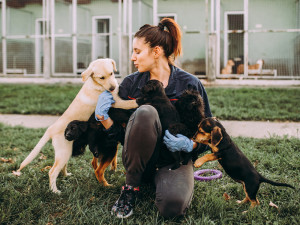You’ve Adopted a Dog From a Hoarding Case. Now What?
Hundreds of dogs have been rescued from hoarding situations so far this year. Here’s what their adopters should know, according to animal welfare experts.
Living on a farm with dozens of dogs is the dream, right? You’d think so, but it can actually be a real a nightmare — at least for the dogs. In March of this year, 121 injured and malnourished dogs were found in Ector County, Texasopens in new tab; some were feral and had seemingly never interacted with a human before. And earlier this July, a woman was prosecuted for hoarding three cats and 28 dogs in unsanitary conditions for years. “Many of them are on vet care,” Julie Larish, one of the animal rescuers on the case, told The Times Leaderopens in new tab. “We have some severe anemia issues going on, but we are working on them. We had two that were near death with anemia. The vet said two more days they would have been dead.”
Hoarders have trouble parting with possessions because they feel like they need to save them. (We’ve all seen the reality show, right?) For animal hoarders, however, it’s not all about them. One rescue pup becomes two, then three — or a dozen if they aren’t spayed or neutered. Before they know it, their bleeding heart has caused the situation to spiral and they are up to their eyeballs in dogs and/or cats who they simply cannot feed or vet, not to mention train or socialize.
Rescuing Dogs from Hoarding Cases is Just the Beginning
When dogs are rescued from hoarding situations, understandably, the trauma can often stay with them for some time, and it can take them a while to figure out not just how to be a dog, but a pet too. For the adopter of one of these lucky pups, it can be heartbreaking to see them struggle to navigate their new world at first, though it’s ultimately a rewarding experience — especially when you see that first tail wag! But until recently, rescuers and trainers barely grasped how best to help these dogs recover.
Enter: Dr. Frank McMillan, director of Well-Being Studies at Best Friends Animal Societyopens in new tab in Utah, and Dr. James Serpell, director of the Center for the Interaction of Animals and Society opens in new tab at the University of Pennsylvania School of Veterinary Medicine. They have each dedicated their life’s work to understanding trauma in dogs, and a few years ago, they teamed up to study a specific group: those rescued from animal hoarders. Their research revealed these dogs’ unique needs, and in doing so, suggested how to address them.
How much do you spend on your pet per year?
Dr. McMillan had questions: What’s different in the behavior of dogs who have been abused? What about dogs who lived as breeding animals in puppy mills, or in a hoarding environment? And Dr. Serpell provided the means for finding answers: a validated questionnaire that the two researchers use to measure dogs’ behavior, and a massive database populated with information gleaned from 16,000 questionnaires filled out by dog parents from all over the world. This database allowed the researchers to compare the behaviors of the average dog to the behaviors of dogs from hoarding environments.
Best Friends Animal Society contacted parents and foster parents of previously hoarded dogs and asked them to fill out questionnaires about their dogs’ behavior. A comparison of their responses to that of the “average” dog parent in Dr. Serpell’s database provided the first scientific insights into how these dogs behave.
Measuring the Trauma and Behavior of Hoarded Dogs
Measuring a dog’s personality is a difficult task, highlighted by the question of whether their behavior on the day it is measured has any relationship to their behavior on any other day. In other words, is a dog’s behavior at any given point in time actually a window into their personality? Dr. Serpell’s questionnaire, the Canine Behavioral Assessment & Research Questionnaire (C-BARQ), addresses this by asking the pet parent — the person who knows the dog best — to supply the information. The 100-item survey includes questions about the dog’s responses to specific situations, such as meeting unfamiliar dogs or visiting the veterinarian. Dr. Serpell’s team grouped the questions into related categories so that conclusions could be drawn about a dog’s general personality (e.g. excitability and train-ability) and behavior issues (e.g. stranger-directed aggression and dog-directed aggression).
In order for McMillan to be able to help potential adopters of hoarded dogs know what to expect, he needed to make comparisons. But this proved to be somewhat trickier — determining the ways in which these dogs’ behavior differed from the behavior of normal dogs first required a definition of “normal.” What is a normal dog? How likely is it that any dog will have aggression problems toward other dogs, and how much more likely is it that a dog from a hoarding situation will display aggression? To find out, Dr. Serpell queried the C-BARQ database, which — when compared to American Veterinary Medical Associationopens in new tab surveys — appears to provide a good representation of the variety of dogs living in U.S. homes.
The Unsurprising Results from the Study
Some of the results of the comparison between the two groups of dogs were what the researchers expected. Dogs from hoarding environments were dramatically more likely to be fearful of people, other dogs, or just the world in general. (A terror of new things — and to them, everything is new — is one of the hallmarks of a dog from a hoarding situation.) Additionally, hoarded dogs have no opportunity to learn good house manners, and are more likely to go to the bathroom in the house when left alone than the comparison dogs. Many of these dogs also dislike being touched or restrained, but simultaneously show a deep neediness and desire to be near people.
These results paint a picture of a dog who is not equipped at a basic level to interact normally with the world, and who is desperate to relate to humans but is not quite sure how to go about it. Dr. Serpell wonders if these attachment disorders are due to the disruption of the normal environment early in the dogs’ lives, followed by an environment with little to no individual attention. “You take them out of that situation,” he says, “and it looks like they hyper-attach to the new owner.”
The study also turned up an increased incidence of compulsive behaviors in dogs rescued from hoarding environments including spinning, pacing, or licking blankets, carpets, or even themselves. These repetitive behaviors, known as stereotypies, also appear in animals kept captive in other restricted, barren environments such as shelters and zoos with sub-standard facilities. Stereotypies are thought to help animals deal with stress, and may remain even after the animal is in a less stressful environment.
The Surprises — Good Ones!
Some of the results surprised the researchers, however. Although they suspected that many dogs in hoarding situations have had traumatic experiences with other dogs, the dogs in the hoarded group were less likely to display aggression towards strange dogs or dogs in their household than the comparison dogs were. As Dr. Serpell speculated, “You could imagine that in a hoarding household, where there are literally hundreds of dogs, any dog that engaged in dog rivalry is going to have a difficult time, so it kind of gets trained out of them. So they don’t show this type of behavior to the same extent as dogs living in, say, a two-dog household.”
He was also quite interested in finding that dogs from hoarding situations appeared less likely to engage in persistent barking than dogs in the comparison group, unless they are rehomed with other dogs. “Barking, we know, is something that’s socially facilitated. So when one dog barks, it tends to trigger other dogs barking. It may be that these dogs are subjected to such incessant barking because of the numbers of dogs [in the hoarding environment] that they may habituate to it, and they no longer respond,” Dr. Serpell hypothesized. “Interestingly, when you take them out of that situation, that habit of barking doesn’t come back unless they’re in a household with another dog, which triggers the behavior again.”
Many of the behaviors — or lack of them — described in these dogs suggest an animal paralyzed by fear. It shows an animal who has developed learned helplessness and is reluctant to interact with the environment. In addition to decreased aggression, the caretakers of these dogs report decreased trainability, presumably because the dogs avoid interaction. One respondent reported that if something like a baby gate fell on her foster dog, “He would not even move out from under it, but would lie there passively.”
What This All Means
Because dogs are individuals, both Dr. Serpell and Dr. McMillan caution against over-interpretation of their results. The trauma of living in a hoard isn’t the same for any two dogs. “As part of a slide show, I present one case example of six dogs who came from the exact same facility, who show a huge variation in everything from fear levels to bonding with people,” Dr. McMillan says. The trends in the study are clear, but there are only two of them. Despite evidence that dogs with this background may be more likely to display specific behaviors, there’s no guarantee that every dog from a hoarding situation will. Especially given that, while they’re in the minority, some dogs come out of a hoard with their natural friendliness and sociability intact.
Both Dr. McMillan and Dr. Serpell lamented the lack of complete histories for these dogs. Many are born into hoarding situations, and may grow up without being socialized to humans. If the hoarder was a woman, they may have never seen a male human before their rescue. Others are brought into the hoard as adults, perhaps as part of a dog sanctuary gone tragically wrong. These dogs may have received normal socialization and even training, and therefor may be more able to adapt to life outside the hoard than one who has never known any other life. Whatever the circumstance, all information on origins is typically lost once a dog enters a hoard and the C-BARQ has no way of determining if a particular dog’s resilience is due to an early life in a healthier environment, some minimal amount of socialization within the hoarding environment, genetics, or simply chance.
So, Is Canine PTSD Real?
Dr. McMillan remarked on how the individuality of each dog’s response mirrored the varied responses of humans to trauma. When asked if he felt that these dogs suffered from post-traumatic stress disorder (PTSD), he said that some of the aspects fit the criteria used to diagnose PTSD in people, “but not exact enough to where we can call it that… Part of the PTSD diagnosis involves things going on cognitively that we can’t delve into with dogs, such as intrusive memories, flashbacks, nightmares, that kind of a thing. So I hesitate to give that label to any of this.” He added that adopters of hoarded dogs frequently report that the dogs have what appear to be nightmares. In a follow-up to the original survey, he asked these adopters what human diagnosis they felt best fit their dogs and more than half of them listed PTSD.
In that follow-up survey, Dr. McMillan also asked adopters about their experiences with these dogs and received responses from 296 participants. This survey had no comparison group of “normal” dogs and the adopters who chose to answer may have had more positive experiences with their particular dogs. Nevertheless, their responses were enlightening.
Patience and Positive Reinforcement are Key
They describe dogs who lack trust in the world, ones so fearful of being in a cage that they nearly stop breathing when kenneled at a veterinarian’s, who enter long fugues of licking the ground or a carpet. But the same dogs are also described as providing deep delight to their pet parents that cherish every tiny step forward. These dogs can bond very closely — the terrified animal visitors see is not the same as the loving dog the pet parent sees. Most importantly, the respondents spoke about dramatic improvements. Many of these dogs will never be functionally normal, but over years of living in a healthy environment, their behavior has changed dramatically.
While more than two-thirds of respondents said they felt their dogs still had improvements to make in their behavior, they reported that they had already seen great advances in the dogs’ level of happiness and quality of life. As one wrote, “She is truly a happy, happy little soul when she is inside of her comfort zone.” Tellingly, 93 percent wrote that they would be willing to adopt this same dog again, even knowing what they now know about their behavior.
Dr. McMillan cautions against pushing these dogs too hard. For any fearful animal, but particularly ones from hoarding cases, punishment may result in a setback. Adopters report that even strong words may be too much. The treatment that helped most was patience. Adopter after adopter wrote about learning to let the dog take each new step at their own pace. Pushing them before they were ready could result in increased fear. But giving the dog time to slowly learn that the world isn’t so scary reaped enormous benefits.
Other strategies included avoiding eye contact, which helped them gain confidence. For dogs who were afraid of hands, reinforcement with treats (tossed, not handed to the dog), rather than petting, was helpful. Some also benefited hugely from living with another, well-socialized dog who could show them the ropes and demonstrate how to be affectionate with humans. As some dogs came out of their shells, they responded well to positive reinforcement training in classes like agility, obedience, and nosework.
More Support Needed
Regrettably, those who adopted dogs from hoarding situations reported having difficulty finding support helping their dogs adjust. Though many trainers refer to themselves as behaviorists, for a dog with severe behavior problems such as the ones exhibited by many of these hoarded dogs, pet parents would do well to seek out professionals with advanced behavior training. Because many hoarded dogs display deep-seated fear for which medication can be helpful, a veterinary behaviorist who can prescribe medication may also be particularly helpful.
Dr. McMillan is doing his best to provide information about what to expect from hoarded dogs and how to treat them. He published a manual, “Understanding and Caring for Rescued Hoarded Dogsopens in new tab,” that includes insights and quotes from the follow-up survey, as well as statistics, and Dr. McMillan’s own interpretations of what he found.
Dr. McMillan and Dr. Serpell believe that their study is the first to describe the behavior of dogs — or, in fact, any species — rescued from a hoarding environment. Ideally, more studies will follow, as we still don’t know enough about these dogs and how to help them. The hoarding environment is a difficult one to study, as alien to a healthy household as Antarctica is to Florida. Those who adopt these dogs need to be able to make informed choices about treatment strategies. Trying to adjust to the new and strange world of being a human’s companion must seem an almost insurmountable task to a once-hoarded dog. These dogs, and those who take them in, deserve our help.

















